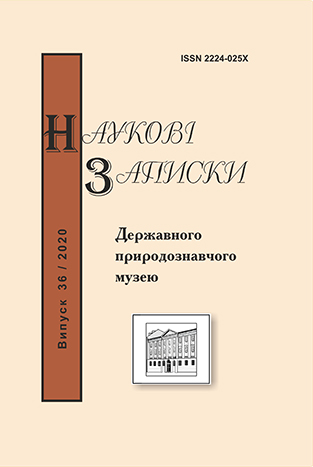Chernobay Yu. Museum representation of coevolutionary metamorphosis of the environment and behavior // Proc. of the State Nat. Hist. Mus. - Lviv, 2020. - 36. - P. 3-14 DOI: https://doi.org/10.36885/nzdpm.2020.36.3-14 Key words: community, environment, coronavirus infection COVID-19, self-isolation, fragmentation, social barriers, social behavior, coevolution The museum serves as an effective tool for learning and evaluating the latest signs of valorization of natural objects and environmental and social phenomena. Unlike departments and institutes specialized in biological disciplines, the museum has a wide range of cognitive competencies for the public. Social isolation, active transition to remote methods of communication, as well as psychological tensions make clear the socio-natural problems that existed before the pandemic. Along with a clear differentiation of methods of behaviorism and ethology, their nomenclature additions, it is necessary to use important manifestations of the integration of these areas of psychology. To solve this methodological problem by force only by methods of museological interpretations.
The paradigm of coevolution provides an opportunity to operate with the concept of evolutionary process in relation to heterogeneous socio-biotic systems. In the Carpathian region, the sociological strategy should integrate the positive aspects of fragmentation. Models of such coevolutionary integration are various complexes – from indigenous soil-detrital complexes of substrates and reducers to coenopopulations of species. It is the soil profiles of succession series that reflect the history of coevolution of secondary ecosystems and act as reliable benchmarks in the diagnosis of probable changes. Behavioral principles of behavioral ecology should become a normative element in the knowledge of coevolutionary changes, and the museum serves as a universal center of analysis and forecast of further coevolutionary development of human-nature relations.
References
- Vernadskiy V.I. Izbrannyje trudy po istorii nauky / V.Y. Vernadskiy. - M.: Nauka.– 1981.- 359 s. [In Russian]
- Vernadskiy V.I. Razmyshleniya naturalista. Nauchnaia mysl kak planetnoe yavlenie / V.I. Vernadskiy.–M.: Nauka. -1977. - Kn.2. - 192 s. [In Russian]
- Vovk O., Orlov O. Gruntove riznomanittia oselyshch (habitats) Ukrainskykh Karpat i perspektyvy yoho okhorony // Biolohichni studii / Studia Biologica : chasopys / O.Vovk, O.Orlov. 2014.-t. 8, 3–4. - S. 157–168. [In Ukrainian]
- Harbuzova, V.Yu., Yanchyk H.V. Slovnyk fiziolohichnykh terminiv: terminolohichnyi slovnyk / V.Yu. Harbuzova. - Sumy : SumDU, 2008. - 146 s. [In Ukrainian]
- Hyppenreiter Yu. B. Vvedenie v obshchuiu psykholohiiu / Yu. B. Hyppenreiter. - M.: Yzd.«CheRo» y «Iurait», 2002. – 336 s. [In Russian]
- Holubets M.A. Seredovyshcheznavstvo (invaironmentolohiia)/ M.A. Holubets. - Lviv : Komp. "Manuskrypt". 2010. – 176 s. [In Ukrainian]
- Holubets M.A., Hnativ P.S., Kozlovskyi M.P. Kontseptualni zasady staloho rozvytku hirskoho rehionu/ M.A. Holubets. - Lviv: Polli, 2007. – 286 s. [In Ukrainian]
- Lamark Zh.-B. Fylosofiya zoolohyi / Zh.-B.Lamark. M.; L.,1935. t.1. - S. 66 - 67. [In Russian]
- Margulis L. Rol simbioza v evoliutcii kletki / L. Margulis. – Moskva : Mir, 1983. – 351 s. [In Russian]
- Moiseev N. N. Eshche paz o probleme koevoliutcii / N. N. Moiseev // Voprosy filosofii. – 1998. - № 8. – C. 26-32. [In Russian]
- Severynovska O. V. Etolohiia (osnovy povedinky tvaryn) / O. V. Severynovska, O. Ye. Pakhomov, V. K. Rybalchenko. – Dnipropetrovsk : Vyd-vo DNU, 2010. – 292 c. [In Ukrainian]
- Sorokin P. A. Sotciologiia revoliutcii: monografіia / P. A. Sorokin. – Moskva : ROSSPEN, 2005. – 704 s. [In Russian]
- Chernobai Yu. M. Do istorii metodolohii tsilisnosti ta paradyhmy pryrodnycho-sotsialnoi koevoliutsii / Yu. M. Chernobai // Nauk. zap. Derzh. pryrodozn. muzeiu. – Lviv, 2019. – Vyp. 35. – S. 3-34. [In Ukrainian]
- Shimming R. Biosfera V. I. Vernadskogo i gipoteza D. E. Lavloka o Gee / R. Shimming // Moskva : Noosfera. – 2013, № 3. – S. 214-215. [In Russian]
- Iung K. G. Vospominaniia, snovideniia, razmyshleniia: monografiia / K. G. Iung. – Minsk : OOO Kharvest, 2003. – 496 s. [In Russian]
- Czarnobaj J. Wpływ fragmentacji na mezofaunę glebową w ekosystemach Górnego Dniestra: часопис. Zarządzanie ochroną przyrody w lasach / J. Czarnobaj, O. Jawornicka. Polska, Tuchola : Wyd-wo WSZŚ w Tucholi. – 2018. – S. 87-109.
- Lovelock J. E. GAIA: A New Look at Life on Earth / J. E. Lovelock. – New-York : Oxford University Press,1979. – 252 p.
- Meller H. Patrick Geddes: Social Evolutionist and City Planner / H. Meller. – London-New York : Routledge,1990. – 384 p.
- Nusbaum-Hilarowicz J. Idea ewolucyi w biologii: przeszłość, stan obecny i wpływ na rozwój wiedzy ludzkiej / J. Nusbaum-Hilarowicz. – Warszawa : Drukarnia Ludowa (Lwów : H. Altenberg), 1910. – 555 s.
- Paczoski J. Żyćie gromadnę roślin / J. Paczoski // Wszechswiat. – 1896. – T. 15, № 26. – S. 401-404; № 27. – S. 420-423; № 28. – S. 443-446.
- Vernadski W. La Biosphère / W. Vernadski. – Paris : F.Alcan, 1929. – 232 p.
- Vernadsky W. I. The Biosphere and the Noosphere / W. I. Vernadsky. – American Scientist. – 1945. – T. 33. – P. 1-12.


